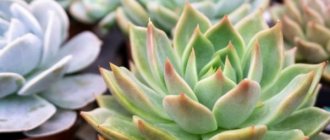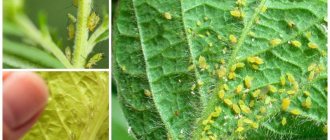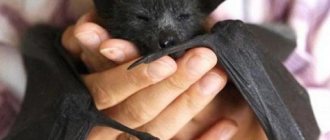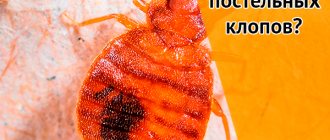The ladybug is a small, brightly colored bug that is familiar to everyone. The red back with black dots attracts the attention of adults and children when the insect crawls along a green leaf. In addition to its charming appearance, pleasing to the eye, the insect has a quality that benefits people - this predatory creature destroys insect pests in household plots and vegetable gardens.
So some summer residents breed ladybugs at home, then plant them in the garden to control pests without the use of chemicals, using environmentally friendly methods.
Ladybug at home
The ladybug is a small, brightly colored bug that is familiar to everyone. The red back with black dots attracts the attention of adults and children when the insect crawls along a green leaf. In addition to its charming appearance, pleasing to the eye, the insect has a quality that benefits people - this predatory creature destroys insect pests in household plots and vegetable gardens. So some summer residents breed ladybugs at home, then plant them in the garden to control pests without the use of chemicals, using environmentally friendly methods.
Why are insects bred?
It is difficult to call ladybugs domestic insects. However, they are often bred for biological control purposes:
- At the end of the warm season, summer residents themselves catch adult insects, leave them for reproduction, and then release them on their own plot next spring;
- for commercial purposes - for sale in private farms and farmsteads.
If you are lucky enough to save a ladybug from freezing in the fall, you can leave it for the winter and release it into the wild next season.
At home, ladybugs are able to actively reproduce. In artificially created conditions, the reproduction process is very active, so the number of insects increases quite quickly. Both fertilized ladybird eggs and healthy mature individuals for individual breeding are suitable for sale.
Homemade
Ladybugs grow quite quickly.
- The female lays 20-40 yellow eggs.
- After a week, larvae emerge from them. Outwardly, they are completely different from adult insects of their species; they can be compared to a crocodile. The larvae have a large head, an elongated spindle-shaped body, and 3 pairs of legs. The colors are bright, repelling predators. Sickle-shaped jaws. The larvae feed on the same types of insects as the adults.
- After a month, the larva pupates.
- An adult insect lives up to 2, rarely up to 3 years.
Ladybug habitat
Ladybugs are distributed almost throughout the planet, with the exception of the permafrost zone and Antarctica. According to different biological classifications, researchers identify from 6 to 8 thousand species of ladybugs. They are not only red with black dots, but also vice versa. There are yellow, white, blue and even black beetles. There may be 2 points, several or none at all.
They live on trees and bushes, in the grass. They are active in the cool morning or evening hours.
In temperate latitudes, ladybugs overwinter:
- in the roots of trees;
- in piles of fallen leaves;
- in cracks under the bark of trees;
- in holes under stones;
- under the top layer of soil.
At the same time, the insects cluster together. The accumulation of identical individuals allows each to maintain a body temperature higher than in the environment.
On a note! The orange trail that a disturbed ladybug leaves behind is hemolymph, which replaces blood for insects. It is distinguished by bugs from the knee joints. The liquid has a very caustic composition, which makes ladybugs inedible for most insectivorous vertebrate creatures.
How to purchase
As you know, the main thing that ladybugs eat is aphids. Since this insect and its larvae are very useful for growing crops, many farmers would like to have them in their fields. Today it is very easy to do. You can simply buy them, create the right conditions for them and plant them in your garden or field.
The eggs of these aphid killers can be purchased not only in gardening centers, but also simply on the Internet. The order will arrive by mail. All that remains is to breed the beetles.
One of the conditions is a complete rejection of pesticides. Otherwise, insects will not live in an environment unsuitable for them. They should be released into the garden at cooler times of the day: in the morning or evening. If there is no dew, you should spray the plants with water. That's all you need to know about breeding ladybugs. These rules are quite simple, and the benefits from these insects are disproportionately high.
Nutrition and maintenance
In order to feed a ladybug, you need to know what it eats. Young individuals are very voracious. Ladybugs eat:
- aphids are the main source of food;
- psyllids;
- scale insects;
- scale insects;
- ticks.
Therefore, they can most often be found under the leaves of trees and plants, as well as in crevices of buildings and wooden window blocks.
Transparent glass or plastic containers with a closed top are ideal for home improvement. The best option would be a bottle or food box with a lid. But we should not forget that every living organism requires oxygen for life and development, so small holes must be made in the lid to allow air to enter the container.
The cow's home should be of such a size that it can fly short distances. A twig or any object with an internal hole is perfect as a sleeping place so that the animal can hide there. For variety and beauty, you can add flower petals or grass to the “interior”. It is important to prevent the leaves from rotting and drying in the container , changing them every two days.
It is not recommended to store the glass “house” in places with direct exposure to sunlight, since strong heating of the vessel can lead to detrimental consequences for the insect.
Food for keeping ladybugs at home can be:
- honey;
- sugar;
- lettuce;
- raisin;
- apples.
Water plays a special role in the nutritional diet of any organism. For convenience, you can place a metal bottle cap in your home and fill it with water. The water level in the drinking bowl should not exceed the height of the beetle's body so that it does not drown. It is enough to feed and water the insect 2-3 times a day, but it is important not to overfeed it. Meals should be taken in small portions.
Reproduction
In spring or fall, ladybugs lay yellow eggs on plant leaves. Their number varies from five to three hundred pieces. The larvae appear within a week. They have well developed jaws. Larvae eat more food than adults. They have a dark green color that camouflages them against the background of the leaves.
After two weeks, a pupa forms from the larva, and after the same period of time, a young ladybug bug appears. At the beginning, he has no patterns on his wings, and the color is still too pale. Over time, the beetle acquires a rich color and pattern. The entire development process from egg to mature individual takes four to seven weeks.
Having completed its mission, the ladybug dies. The insect's life cycle lasts just over a year. A new generation of ladybugs will soon prepare for the winter, after which they will hatch their offspring and then also die.
Looking at this cute insect, many wonder what ladybugs eat. Let's look into this further.
Give up chemistry
Pesticides do not differentiate between good and bad insects; they kill them all. If you have previously treated the plants with chemicals, ladybugs will definitely not land on them.
Once you have attracted beneficial insects, you can encourage them by periodically feeding them with a homemade liquid food solution. Mix equal parts water and brewer's yeast with a little honey and spray throughout the garden. Pour the solution into an aerosol can and spray it onto the surface of the plants.
Interesting to know
Folklorists believe that the name of the beetle is directly related to the ancient Slavic pagan goddess of agriculture and fertility Mokosh. The flight of an insect from the finger was accompanied by the well-known request for bread (“fly to heaven, bring me bread”) as a symbol of productivity and prosperity. This explains her divinity.
Ladybugs are insects popular due to their bright colors. The best habitat for ladybugs is the wild, but if you are lucky enough to find an insect near your home and want to take care of it, it is not difficult to do so - provide the ladybug with food, water and recreate the natural conditions of its habitat.
Do you think I've gone completely crazy?
It was found in the leaf litter that I brought from the forest. More precisely, there are a ton of ladybugs there) but I didn’t tell the children about that
In short, they found one and put it in a jar and released it into the street. Then we spent the whole evening staring at the jar, and as a result, this jar has been at home for 3 days, and the children are crying over it, they are used to it, and do not want to let go.
I had to dive into the Internet) and this is what I found!
Description
Perhaps this is the most famous representative of beetles for both adults and children. There are few people who would not know what a ladybug looks like.
This insect has a round body. It is convex on top and flat on the bottom. The most common ladybugs in nature are red and yellow with black spots on their backs. But these are not all types. There are about four thousand of them in total. Ladybug also comes in black, blue, cyan and other colors.
Instead of dots on her back, she may have stripes and even patterns that resemble letters.
Bright coloring is necessary for the ladybug to protect itself from predators. If this insect gets caught in a spider's web, it has a chance of salvation, since the enemy himself tries to get rid of such a captive by breaking his own trap.
The ladybug has a pair of wings with which it can fly. They are protected by a pair of elytra located on top.
There is a pair of black antennae on the head. The ladybug has three pairs of long legs. A liquid with an odor is released from their folds when the insect senses danger. Ladybug has the ability to play dead if something threatens her. She falls on her back and presses her paws.
Care and caution
The ladybug is small (an adult reaches an average of 0.8−1 cm) and fragile, so any attempt to pick it up or play with it can lead to negative consequences. Precautionary and careful measures when caring for a bug are the following:
- It is better to catch the animal with a net.
- In order to take an insect in your hand, you need to place your finger next to it and wait for it to climb onto it.
- The ideal temperature for life and reproduction of Coccinellidae is considered to be +20 ⁰ C, so it is recommended to avoid hypothermia.
Do not forget that your pet is an insect, so after each contact with it it is recommended to wash your hands thoroughly with soap.
What does a ladybug eat in winter?
In winter, ladybugs do not feed on anything, as they hibernate or go into a state of suspended animation. Before winter, ladybugs accumulate glycerin and sugar in their tissues, and also remove large amounts of water from the body, so that when cold weather sets in and the body cools, they do not burst from the temperature change.
With the onset of cool days, insects begin to look for warm places to winter. Ladybugs can concentrate in large numbers in one place for the winter. Before wintering, insects fly in flocks over the city in search of a new shelter. Most often, ladybugs remain for the winter in heaps of dry leaves, in bark, under stones, in forests, in window cracks, sometimes organizing huge clusters. There are often cases when ladybugs fly into private houses and apartments, hide in window frames, behind curtains, behind baseboards and in other inconspicuous places, and then the owners find them in a sluggish state of winter suspended animation.
Ladybugs are very useful: they themselves and their larvae feed on pests - aphids. So if ladybugs decide to spend the winter in your garden plot, you can be sure that in the summer you will be protected from aphids in your garden. But do not rush to completely plow the area, otherwise you will lose your defenders from aphids for a long time. For this small predator, only the human hand is dangerous; they die en masse from the poisons that gardeners spray their gardens with. Therefore, leave a few places with fallen leaves so that the cows have a place to hide and survive the winter.
The ladybug has wings and is a flying insect; among them there are breeds that are called “migratory”. They are like birds; they can fly away for the winter away from their feeding area. But naturally, they hibernate there too, only in huge groups, sometimes even weighing several tons.
The life cycle of these insects
There are approximately 2 thousand ladybugs in the living environment. This beneficial insect has practically no enemies.
Only rare birds (such as the flycatcher or nuthatch) eat them. Most mammals simply do not have time to catch the dexterous bugs, because they make 85 strokes per second. A distinctive feature is the three-part legs. By the 5th month of their life, insects reach sexual maturity; in April they begin their active breeding season. At this moment, the ladybug needs to feed especially intensively in order to get healthy offspring.
Of the large number of eggs laid, not all will begin to develop—some of the embryos will die in the process. The emerging larvae may also consume the remains of such unborn creatures. A full-fledged bug grows in one month.
The warm months are for the ladybug to accumulate reserves for the winter. At the first sign of frost, they begin to hibernate in order to lay larvae in the spring. With the advent of new offspring, the cow's life cycle ends.
For habitat, insects most often choose plants infected with aphids. And some species live on reeds near water bodies or in field grasses. Almost all of them lead a separate lifestyle and are independent. The only exception is the mating season.
Beetle helping gardeners
Ladybugs or Coccinellidae are a member of the beetle family whose main diet consists of aphids. In search of food, ladybugs migrate for the winter and return in the spring. In some way they are migratory insects. They are engaged in the extermination of aphids from spring to late autumn. After this, eggs are laid near the aphid colony.
Somewhere from 14 0C, ladybugs fill meadows, fields and other flowering and fragrant lands. Alfalfa and barley fields are the most pleasant for cows. These territories are so attractive for Coccinellidae because they are extremely attractive to the main nutritional unit of ladybugs, namely aphids.
During the larval stage, the ladybug consumes about a thousand aphids. In its adult state, an individual eats two hundred insects. Thus, the Ladybug is a farmer’s best friend, just as a dog is a man’s best friend.
Where to find insects?
Do you want to get some ladybugs? There is a lot of time for this - from early spring to the end of summer, insects are active and lead their usual way of life. Most often they are collected mechanically. To do this, they go to the edge of the forest, to a field, or to a ravine. But how can we see small insects in the motley, multi-colored palette of the plant world? It turns out that there are plants that attract ladybugs. Therefore, it is worth taking a closer look at tansy, yarrow, daisies, dill and other members of the Asteraceae family. If you do not come across these plants, go to a buckwheat field or a field sown with oats.
Found a ladybug: what to do?
The best advice is to release it into the wild, but if it gets sharply cold outside, you can help the insect survive the winter by moving into your apartment.
Take a glass liter jar, put some twigs and sticks on its bottom and carefully transfer the insect into it. Ladybugs should be fed with sugar or honey diluted in water.
(for these purposes, you can use a folded small piece of gauze or cotton wool dipped in sweet syrup). They will definitely like this delicacy.
After feeding the unexpected guests well and watching them for a while, you should put them to bed. For ladybugs to fall asleep, the temperature must be below room temperature. The ideal place is between the window frames.
Place the jar there and cover it loosely with a cloth. The light will not disturb the cows, and the air needed for breathing will calmly penetrate inside.











